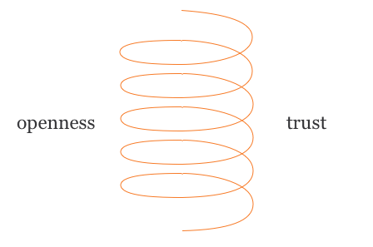Before joining Zooma as an Art Director, I attended Hyper Island in Stockholm—a school that focuses heavily on team dynamics. I remember that one of the first things we got to learn about was the trust and openness spiral. It’s a simple but powerful reminder that is applicable to many fields.
So what is the openness and trust spiral?
Anders Wendelheim developed the openness and trust spiral. It’s simple. There’s a feedback loop present with openness and trust. If we are able to be open with each other, without fear of being rejected for showing ourselves as vulnerable, we can trigger a spiral of openness and trust.

Openness & Trust Spiral
The reason we learned about the openness and trust spiral at Hyper Island was so that we could build better and more effective teams. Within teams this helps with presenting ideas, giving and receiving feedback, and in the end, will result in a better product.
How can this be used for inbound?
In today’s day and age where dark patterns, designs made to trick you into taking a certain action, are seemingly “everywhere” online. And with the rise of privacy concerns, gaining a user’s trust is key. By being open about your intention you gain trust from the user which in turn makes the user more likely to be comfortable with moving into the next stage of the inbound lifecycle stage. A transaction of details in exchange for valuable content is a fair deal. Tricking the user into submitting details in exchange for spam is not. Inbound is all about transparency; design in 2020 should be as well.
If users are informed, and designers honest—there’s no need for dark patterns to force you into making a certain decision.
Here are some tips on how you or your team can become more open and trustworthy:
- Actively seek feedback from your peers and your clients. Trust and openness are infectious, and you’ll find soon enough that people will be turning to you for opinions.
- Practice empathy. Get into the mindset of your users, your peers, your client. In the end, they could be the ones using your product.
- Get to know your co-workers personally. A company trip isn’t just a nice and relaxing thing, it absolutely helps with design. Being able to personally trust someone helps you trust them with feedback, and they’ll feel better about giving feedback as well.
- Don’t just look at the latest design trends, seek out design that dares challenge the norm. Stay open to change.
Are you planning your next inbound campaign? Practice openness and trust with your next inbound campaign. Discuss this checklist with your team to take your inbound efforts to the next level.

You can also read this article in Swedish on Onlineguiden.






